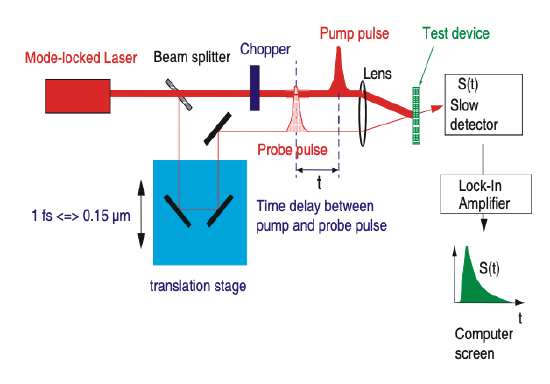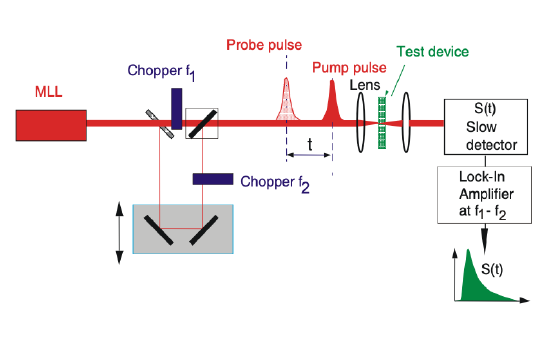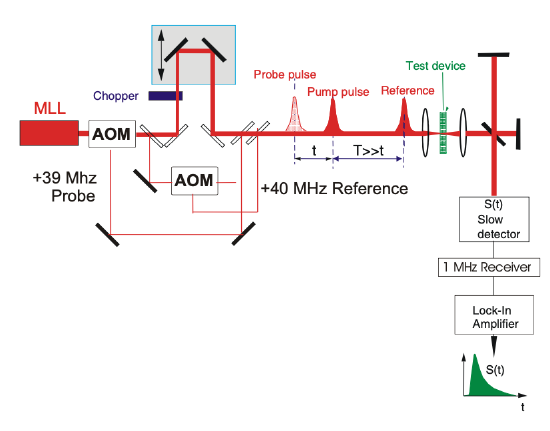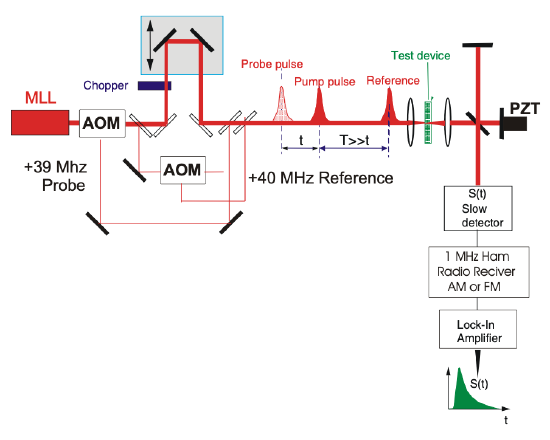11.1: Pump Probe Measurements
- Page ID
- 44683
11.1.1 Non-Colinear Pump-Probe Measurements
Figure 11.1 shows a non-colinear pump-probe measurement setup. To suppress background light and low frequency noise of the probe beam the pump beam is chopped. Typical chopper frequencies of regular mechanical choppers are \(f_{ch} = 100Hz − 2kHz\). Mechanical choppers up to 20kHz have been built. With acousto-optic modulators or electro-optic modulators chopper frequencies up to several hundred MHz are possible.

Lets denote \(S_{in} = S_0 + \delta S\) as the probe pulse energy, where \(S_0\) is the average value and \(\delta_s\) a low frequency noise of the pulse source and \(S(t)\) is the probe signal transmitted through the test device. Then the detected signal transmitted through the test device can be written as
\[\begin{array} {rcl} {S(t)} & = & {T(P(t)) S_{in}} \\ {} & = & {T_0 S_{in} + \dfrac{dT}{dP} (P_0 m (t))} \end{array} \nonumber \]
where \(T_0\) is the transmission without pump pulse, P0 is the pump pulse energy and \(m(t)\) the chopper modulation function. It is obvious that if the noise of the probe laser \(\delta S\) is of low freuqency, then the signal can be shifted away from this noise floor by chosing an appropriately large chopper frequency in \(m(t)\). Ideally, the chopper frequency is chosen large enough to enable shot noise limited detection.
Sometimes the test devices or samples have a rough surface and pump light scattered from the surface might hit the detector. This can be partially suppressed by orthogonal pump and probe polarization
This is a standard technique to understand relaxation dynamics in condensed matter, such as carrier relaxation processes in semiconductors for example.
Colinear Pump-Probe Measurement:
Sometimes pump and probe pulses have to be collinear, for example when pump probe measurements of waveguide devices have to be performed. Then pump and probe pulse, which might both be at the same center wavelength have to be made separable. This can be achieved by using orthogonal pump and probe polarization as shown in Figure 11.2 or by chopping pump and probe at different frequencies and detecting at the difference frequency, see Figure 11.3.


Heterodyne Pump Probe
The lock-in detection is greatly improved if the difference frequency at which the detection occurs can be chosen higher and the signal can be filtered much better using a heterodyne receiver. This is shown in Figure 11.4, where AOM’s are used to prepare a probe and reference pulse shiftet by 39 and 40 MHz respectively. The pump beam is chopped at 1 kHz. After the test device the probe and reference pulse are overlayed with each other by delaying the reference pulse in a Michelson-Interferometer. The beat note at 1MHz is downconverted to base band with a receiver.

If a AM or FM receiver is used and the interferometers generating the reference and probe pulse are interferometerically stable, both amplitude and phase nonlinearities can be detected with high signal to noise.



